Final report for FNE16-856
Project Information
The purpose of the project was to test the viability of directly sown rice in a cold climate. The plan was to test different methodologies of directly sown paddy rice, and compare them to transplanted paddy rice. The main form of analysis for the project was intended to be a cost–benefit analysis, largely based on labor, cost of production, and yield information. This project was conducted at Wild Folk Farm in Benton, Maine from 2016-2017. The farm manager, Ben Rooney, led the project with help from Caragh Fitzgerald, University of Maine Cooperative Extension, as a technical advisor.
Unfortunately, we had very low success rates for directly sown rice emergence in both years of the experiment. Remaining resources were then diverted to learn what factors could have led to low emergence success (We use the term emergence much more than germination in this study. We soak the rice prior to planting and thus emergence is more prevalent that actual germination – explained in 2015 methods). We believe this was due to dry conditions and bird depredation in 2016 and cold soil temperatures in 2016 and 2017. Our fall and spring emergence studies indicate that Rice seems to emerge best when it is sowed in soil above 50 degrees. The range for emergence was from 12 days to 27 days, which we believe that was tied to soil temperature.
The limited data we were able to gather suggest that for certain operations there is the potential for directly sown rice to be a viable alternative to transplanted rice. Our observational data shows that the upfront costs and annual costs are lower, and its yields are comparable to other directly sown grains in the region. We found labor and inputs for transplanted rice to be twice as high as directly sown rice, which does not include infrastructure costs for raising seedlings. Our few successful directly sown plants had on average a 84% emergence coverage (explained below) and yields of 2516 pounds per acre for the Hayayuki Rice. When that same rice variety rice was transplanted with 100% emergence coverage we recorded yields of 3290 lbs per acre. When we compared the plant characteristics (height, tillers, etc.) of directly sown rice to the transplanted rice of Hayayuki, we found no significant differences.
The final outreach product is a video titled "Paddy Rice Farming in Maine: An Instructional Video" and was released in November 2019. This video focuses on rice production on a small scale human powered farm in Maine with a emphasis on the comparison of directly sown rice and transplanted rice in rice paddies. The footage spans 5 years.
Introduction:
We have not discovered any Northeastern commercial rice farmers that directly sow their rice crop. Akaogi Farm brought wetland rice production to the region by in 2006. The methods they employ, outlined in their “Rice Growing Manual for the Northeast,” follow transplanting practices from Hokkaido Japan, which has a similar growing climate to the Northeast. As indicated at the first rice growing conference, the Akaogi’s believe rice is grown best when transplanted, due to our relatively cool and short growing season. Using intensive practices,
they have reported yields of 6,500 lbs. per acre, twice that of wheat. However they only grow rice on a quarter acre of land, a scale where transplanting works well. No other the rice farms in the region have yet to report yields close to that.
In 2012 Laura Bermingham examined different water management strategies for transplanting rice. The data indicates that their saturation treatment, with intermittent flooding followed by saturation, produces the same yields as fully flooded paddies. Environmentally, saturation offers the benefits of better water management and less methane emissions. This saturation method is based off of the System of Rice Intensification, SRI. Currently Eric Andrus is conducting a study involving water management as well. Like us, he is comparing management strategies and measuring associated costs, labor and yields to try to make rice production more commercially viable. Like Akaogi, he is basing his study on practices in Japan, and the book The Power of Duck.
Here the integration of ducks and azolla, into flooded paddies, keep weed pressure down as well as add fertility. In summer, azolla can fix twice as much nitrogen as alfalfa (Furano, 2001). We have grown azolla with our rice for the past three seasons and will do it again this season.
While insights gained from Hall and Andrus are helpful for transplanted rice, different answers could present themselves for directly sown rice. Two potential drawbacks of directly sown rice are weed pressure and a shorter growing window. A flooded paddy has higher nighttime temperature and this can lead to earlier maturation dates. Pulsing and flooding the paddies throughout the season can help control weed pressure (IRRI 2002).
Most of the information for directly sowed rice comes from the Southern agricultural universities, and from Southeast Asia through Cornell and IRRI. While these areas have a different climate, and in the South, much different growing practices and scales, they can offer some insights into growing methodologies. Suggested broadcasting rates range from 30-125 lbs per acre. Most research does agree that a desired stand of over 30 plants per foot increases susceptibility to lodging (IRRI, 2002 & Wilson, 2015). We seeded our rice last season at 30 lbs. per acre and had an uneven canopy develop. We plan to broadcast at 60 lbs. per acre this season.
Drum seeding rice is a recent development, combining SRI methods into a direct seeding practice. SRI focuses on transplanting young seedling, into a saturation water treatment. These plants are cultivated regularly and receive a lot of organic fertility. Drum seeders sow every eight inches. This equates to roughly 12 lbs/acre. As these densities don’t vary, we will assume that this is a favorable density for directly sowing rice in rows (REDDY 2012).
In Southeast Asia, there is a wealth of information comparing directly sown rice to transplanted rice. Labor information is more useful here than costs comparisons, as economies and labor wages are drastically different. A study out of India reports that a drum seeder can sow a hectare in five to six hours, when compared to three to four days by thirty to forty people to transplant a hectare. This same study put total cost at 300% higher for transplanting rice when compared to the drum seeder method and net returns for the drum seeder method at almost double that of transplanting (REDDY, 2012). “Depending on the nature of the production system, direct seeding can reduce the labor requirement by as much as 50%,” (IRRI, 2002).
Furthermore, mechanical weeders can reduce weed labor time by 50% when compared with hand weeding (Ampong-Nyarko, 1991). To test out the most effective sustainable approach for weed pressure will use a “Conoweeder.” Developed by IRRI, this has been shown to be the most effective non-motorized rotary weeder. It is estimated that about two tons of biomass are added per acre with the incorporation of weeds using this tool (Di
Florio, 2014).
The supply and demand of many small-scale grains is on the rise in the Northeast. However, after ten years of research and production in the region, paddy rice cultivation has yet to become a substantial commercial crop. In our three years of rice outreach and production, we have identified a large and unmet demand for local rice. Still there are only a handful of farmers are growing rice. A major deterrent we have identified for paddy rice farming is the high initial cost. Infrastructure, including paddies, ponds and high tunnels are expensive investments. Additionally, there are substantial labor costs involved to transplant and raise seedlings. On a larger scale, this can mean specialized equipment specific for
paddy production. These costs are reflected in price for rice grown in this region, which is around eight dollars a pound, two to three times that of other grains.
There are three principal methods of rice establishment for wetland production: transplanting, direct seeding by broadcast and direct seeding in rows. Globally, within these three methods there is huge variability of practices (IRRI, 2002). However in the Northeast, we know of no other rice farms that practice any direct seeding methods, nor any research that has been done on the topic.
Preliminary data for this experiment indicates that the viability of directly sown rice in the northeast is worth exploring. In 2013 and 2014 we selectively saved seed from our earliest Hayayuki rice plants. Hayayuki is one of the earliest varieties grown in this region with commercial viability (Akaogi, 2009). In 2015, following density guidelines by the International Rice Research Institution, IRRI, we hand-broadcast rice in 2000 square feet.
As our new paddy system was not complete we could not yet control the water levels before or after flooding. Lastly, this rice was not given the same in-season fertility regimen as our transplanted rice. Its harvest date was September 20th. In the end, with these setbacks the yields were roughly 50% of the transplanted rice. The major benefit of directly sown rice is that it can lower the costs of capital and springtime labor associated with
seeding and transplanting work. Furthermore it does not require the use of the most valuable space on farms in the northeast; high tunnels. Lower inputs and labor demands, especially early in the season will encourage more farms to try rice production. Scalability can also be easier, as farms can increase their size, gain economy of scale, keep high tunnel space free. Lastly they do not need to invest in specialized large-scale equipment, which can cause compaction and deleterious effects on wet clay paddy soil.
We aim to create a sustainable grain model that is non-reliant on fossil fuels while being economically viable for farmers and affordable for consumers.
Cooperators
Research
2016
Three different planting methods were conducted. The first planting method followed the practice of directly sowing rice in rows with more spacing, similar to SRI (System of Rice Intensification) practices, with 15 lbs./acre. One method treatment was mulched and saturated and the other flooded. The second planting method followed a broadcast sowing where plants are spaced randomly and closer together, similar to most commercial grain operations, at 80 lbs./acre. This was also divided into two different treatments, one flooded and one saturated. In the third planting method, we transplanted the rice, following the guidelines of the Akaogi “Rice Growing Manual,” and Wild Folk experience. We sowed the transplanted rice trays in 128 cell flats with 2-3 seeds in each flat. The plants were planted one foot apart. They were sowed on April 28th. All in all, there were 5 different treatments, with four different replications (blocks) of each treatment, spread across six paddies.
Additionally devoted one entire paddy to broadcasting the rice, and one paddy to directly sowing the rice with a row seeder from India. The purpose of the row seeder was to test out the equipment and compare the row seeding method on a larger and more anecdotal scale, as well as use the paddies for demonstration and outreach in order to highlight the differences of direct sowing form transplanting. We grew transplanted rice in the remaining paddies.
Observations in 2016
Out of the 16 DS (directly sown) blocks, only 2 had good coverage (see criteria below under “Results and Discussion”). We decided that measuring emergence coverage would be helpful in this study and did so for 2016 and 2017. Coverage was defined as an area within 8 inches of a rice plant. We recorded the date when over 50% of area was covered with rice if that was achieved, as well as when any remaining rice came up. Most blocks had between 0-15% coverage of rice in 2016. The 2 blocks with a successful rice crop were in the lowest paddy, and they happened to be the only blocks with standing water or saturation during the 2 weeks following the crop sowing.
The plan was for either rain water or water from our pond to help saturate the soil after sowing the crop, although due to abnormally dry May weather, most of the paddies dried up, or at least didn’t go beyond saturation. We received 1 rain event in May, 3 weeks after planting. Redwing Blackbirds and other grassland birds probed into the soil above where we directly sowed the crop.
We did test out the equipment from India, and that observational data is presented in the “Results & Discussion” section.
2017
Changes to experimental design:
After water issues in 2016 the experimental layout was condensed to 2 paddies in 2017 in order to help irrigate these treatments if need be. Based on success with mulch in 2015, bird pressure and dry weather in 2016, we decided to change our treatments. We added a mulch treatment with saturated soils and instead of having two different water management strategies (saturated & flooded) we combined them into one water treatment, slightly flooded or saturated, which was easier to maintain throughout the season.
In 2017 we directly sowed the rice in 2 different paddies from May 9-10, trying to replicate the successful sowing date in 2015. Each paddy had 3 DS treatments that were repeated 3 times. In total we had 18 different DS blocks. We also had 6 control treatments for transplanted rice, bringing the total to 24 blocks. Each block was 5 x 25.
Different planting treatments are listed below:
1: ROW DS: Above ground with seeder: In this treatment we directly sowed the rice in rows, emulating a row seeder, and then used mulch for the treatment or flooding for the treatment. Rice was planted at 15 lbs/acre.
2: ROW BELOW GROUND: Created a trough and sowed in rows and reburied, with hand tools, emulating machine cultivation. Rice buried at depth of 2 inches. These blocks were tried to keep moist and not flooded. Rice was planted at 15lbs/acre.
3: BROADCAST DS: In this treatment we broadcast rice at 80/lbs an acre and then put mulch on it.
Transplant: We followed the same protocol from 2016. We sowed the transplanted rice trays in 128 cell flats with 2-3 seeds in each flat. The plants were planted one foot apart. They were sowed on April 29th.
Prior to directly sowing and transplanting, we made sure all of the paddies were full of water and drained them upon sowing.
In the fall, with another year of poor emergence success, we decided to do experiments to see what factors could be contributing to this. This included sowing the rice in trays, in two different soil media. One was 50/50 potting soil to native clay and one was just potting soil. We also built 6 smaller 5 x 15 foot paddies and evaluated the time to germination with four planting dates from September into October, recording the date when 50% sprouted.
We were able to harvest rice from 4 successful DS blocks from 2017. The rest of the blocks were abandoned due to poor sprouting rates. In the 3 blocks with the best directly sown coverage we followed other Northeast SARE and Cornell Rice data collection and compared this to three of the transplanted blocks. This involved taking the average height of the tallest three tillers, counting the number of total tillers and productive tillers. We took data from ten random plants in each of these blocks and did the same in 3 of the transplanted blocks, all on September 28.
Following other SARE and rice studies from the Northeast, we recorded plant height, yield and tillers in each the 3 most successful directly sown location and the 3 transplanted locations.
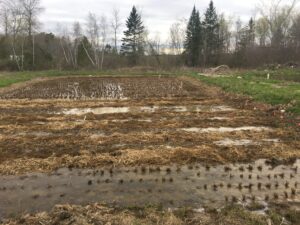
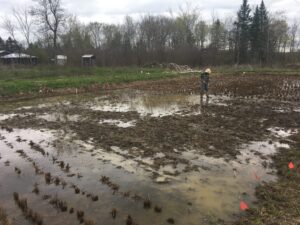
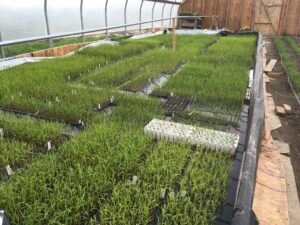
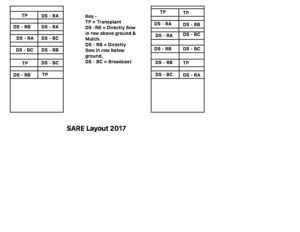
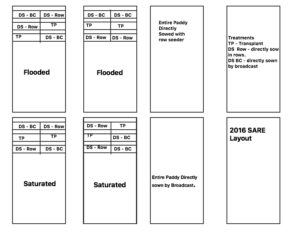
Out of the 34 different DS blocks we only kept 6 for the study, all using the broadcast method. We kept any treatments with over 66% desired sprouting coverage, and decided Treatments with less than 66% desired sprouting coverage were considered seeding failures and typically would not be considered a viable stand by a farmer. For this reason, these plots were removed from the experiment. Coverage was defined as an area within 8 inches of a rice plant. For comparison, in many directly sown operations, there are over 5 plants per square foot.
In 2016 the paddies were extremely dry, with no adequate pond water and only 1 rain event in May, three weeks after planting. 2 blocks were successful, with 75% & 76% emergence density. These blocks were the only ones to be adequately moist and had standing water for much of May. They were in the lowest paddy. 2 other blocks in 2016 had around 25% coverage, and, the other 20 blocks, had 0-10% coverage. Our large scale sowing with the broadcaster and row seeder used in two different paddies was also abandoned due to poor germination.
|
Table 1. Days to emergence & growing degree days for Hayayuki Rice Directly Sown |
||
|
Year |
2015 |
2017 |
|
n |
1 |
6 |
|
Planting Date |
10-May |
9-May |
|
Average Days |
18 |
27.17 |
|
Average GDD @ 50% Emergence |
160 |
184 |
|
GDD accumulation at planting |
75 |
2 |
The farm did receive sufficient rain in 2017, yet only in the broadcast treatments did we get any successful results. The 4 successful ones were found in areas that were higher up and not flooded, but saturated and mulched. Two other blocks, both mulched and broadcast from 2017 had around 50% coverage and everything else was below 10%, with more than half having 0% germination. None of the rice in flooded areas, nor planted underground had a germination rate above 25%. With a wet spring we were unable to keep many of the mulched row treatments from having standing water.
The rice took, on average, 18 days in 2015 and 27 days in 2017 to sprout at 50% desired coverage as shown in table 1. It took the rice between 160 (2015 avg) and 184 (2017 avg) GDD for the rice to emerge. 2015 was the year before we started this SARE Project. N=1 because we were using one block, which was 50 x 25. The higher GDD accumulation at planting, probably indicative of higher soil temperatures, could have contributed to the rice coming up earlier in 2015. In 2016, which was the first year of the study the rice took 27.5 days for our successful treatments to get 50% coverage with a GDD accumulation of 279. This much higher number could be explained by lack of moisture causing a delay in germination and/or emergence.
As germination was our biggest issue, in the fall of 2017 we tried more germination trials in three small paddies, all kept moist and mulched, as shown in Table 2. The data shows that with average air temperatures above 60 degrees the rice comes up in roughly 2 weeks and decreases after that, not emerging in the final trials. We had above 100% emergence coverage in the first three trials. The last trial, with temperatures well below 50 degrees had no germination. We conducted analysis of variance on the time to emergence data for the first three planting dates. The last date was excluded because the rice did not emerge. Analysis of variance showed a statistically significant difference in the number of days to 50% emergence among the three planting dates (p=0.00011). Emergence was fastest for the rice planted Sept. 27 and slowest for the rice planted Oct. 8. Figure 1 shows the relationship between emergence and growing degree days for this trial.
|
Table 2 - Rice Emergence in small paddies in fall for drectly sown Hayayuki Rice |
||||
|
Planting Date |
6-Sep |
27-Sep |
8-Oct |
26-Oct |
|
n |
6 |
6 |
6 |
6 |
|
Avg. Days to 50% |
13.66 |
12.33 |
18 |
No Emergence |
|
GDD (Base 50) |
191.92 |
143.27 |
82.49 |
0.00 |
|
Average Temperature |
64.05 |
61.62 |
54.76 |
39.32 |
|
Temp/duration |
4.689 |
4.998 |
3.160 |
N/A |
Figure 1. Effect of growing degree days on emergence of fall-sown, direct-seeded Hayayuki rice, planted Sept. 6, Sept. 7, Oct. 6, and Oct. 26, 2017.
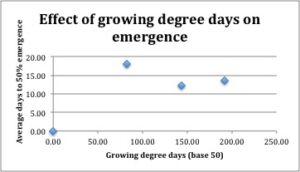
Why did we have success in 2015, the fall trials of 2017 and not the growing seasons of 2016 and 2017? I believe this was mainly due to temperature in 2017. In 2017 the sprouted rice was planted into much colder air temperatures and most likely ground temperatures than 2015, as shown in Table 1. Out of the broadcast treatments more flooding actually seemed to lead to a decrease in sprouting success, and only the mulched & non-flooded rice did well. The directly sown rice treatment that was buried and also the spring flooded treatment would probably be colder in the spring when ground water is moving through the paddies. In the spring it would make sense for the lightly mulched rice treatment to be the warmest. The rice was sown after soaking and when at least 25% had sprouted, so perhaps most of that rice died in environments below 50 degrees, rather than just halt growth, which would explain why only the heavily seeded broadcast came up and the row seeded rice did not. Furthermore maybe the remaining rice that didn’t germinate didn’t die and stayed dormant for a while and then also emerged slower, as suggested by the third trial in our fall data, from Table 2, which shows slower emergence in colder temperatures. Lastly, emergence coverage does not equate to 90% emergence rate. For example in the broadcast treatment we sow the rice very densely, 80 lbs./acre and a 90% emergence coverage could be achieved with less than 25% emergence rate, meaning much of the rice could have died due to cold temperatures and we still could have got a stand worth keeping.
In 2016 I believe moisture and temperature were limiting factors, which could explain why it was the least successful year, why the rice took so many more GDD to emerge and why it only came up in the blocks with adequate moisture.
In the fall we also compared directly sown from a soil media of potting soil and a 50/50 mix of the paddy clay and potting soil, to see if that effected emergence success and duration. Using a two-tailed t-test, we found there was a statistically significant difference between the number of days to 50% germination for rice started in a mix of clay and potting soil and compared to rice started in potting soil alone (p=.03347). When started in potting soil, rice germinated almost three days earlier than when started in a mixture of clay and potting soil (Table 4).
|
Table 4. Effect of growing Medium on emergence of fall planted rice (Hayayuki Variety). |
||
|
Soil Media in 128 cell seedling trays |
1:1 Native clay: potting soil. |
Potting Soil |
|
Planting Date |
24-Sep |
24-Sep |
|
Days to 50% Germination |
13.66 |
10.7 |
|
Average Air temperature over |
62.9 |
64.6 |
In the fall we compared our three most successful directly sown blocks with three transplanted blocks, both of the Hayayuki variety. Drawing on data collection methods from other Rice SARE grants, we looked at tillers, viable tillers and average height of tallest three tillers. Numerically, the number of tillers per plant (average of 10 plants per plot) was higher for transplanted rice than for direct-seeded rice (36 for transplanted, 24 for direct-seeded). Similarly, the number of viable tillers (average from 10 plants per plot) was higher for transplanted rice than for direct-seeded rice (26 for transplanted, 17 for direct-seeded. However, neither of these was statistically significant (p=0.14208 for tillers, p=0.20515 for viable tillers). Tiller height, measured as the average of the tallest 3 tillers for each of 10 plants per plot, was nearly equal between the two treatments (34 for transplanted, 33 for direct-seeded). This was also not statistically significant.
The main purpose of our grant was to compare directly sown rice to transplanted rice, and compare direct sowing methods, though with such poor germination success we were not able to gather adequate data.
Table 5 compares labor for directly sown rice to transplanted rice. The labor for the rice soaking and drying is longer for the transplanted rice due to labor purposes; it requires different batches, as it cannot all be planted in the fields on the same day nor all sown in flats on the same day. We used an Earthway Seeder for broadcasting the rice and then used our rice straw for mulch. A light layer of mulch is necessary to keep the birds out, if flooding isn’t available, at least at Wild Folk Farm. In 2016 we observed Red-Winged Blackbirds digging into the ground and eating much of our seed on barren ground. Using human power, the harvest for transplanted rice takes substantially less time, as the plants are bushier, require less sickle strokes, and are easier to transport and bunch. If we were to use a combine, the labor would not be any different, assuming the rice does not lodge. Other studies have indicated directly sown rice has a higher propensity to lodge. Much of this labor can vary greatly, whether it be from human power or from machine use. We have found that drier & harder paddies can take 4x as long to transplant and weed as wet soft ones.
This huge variability between and within paddies and for weed pressure, as well as logistical difficulties led us to stop tracking weeding labor. Our observations as well as other farming data suggest substantially higher weed pressure for the directly sown crops vs. transplanted ones, but no numbers are represented in this study for that.
|
Table 5. Labor Comparison of directly sown rice and transplanted rice for Planting & Harvesting Labor in 1 acre |
||
|
Item |
DS Rice |
Transplanted Rice |
|
Rice Drying |
2 |
10 |
|
Broadcast |
3 |
0 |
|
Mulching |
24 |
0 |
|
Seedling Sowing |
0 |
50 |
|
Transplant Maintenance |
0 |
28 |
|
Transplant Time |
0 |
96 |
|
Harvest |
72 |
48 |
|
Total Amount ($10/hr) |
1010 |
2320 |
Table 5 and 6 also show much higher costs for transplanted rice. Calculating the cost for high tunnel space can be difficult because there is a wide variability in structures, different opportunity cost for the high tunnel space, if existing structures exist and the rate of attrition of those structures. Directly sown rice also requires more mulch and rice seed, which would be for cost effective for an existing rice farm.
|
Table 5 - Yearly Cost comparison of directly sown rice |
|||
|
Yearly Cost |
Directly Sown |
Transplanted |
Notes |
|
Rice Seed |
$800 |
$50 |
$10/ Pound |
|
Mulch |
$750 |
$0 |
$30 a bale at 25 bales |
|
Trays (20% yearly) |
$0 |
$10 |
5 year replacement rate |
|
Potting Soil |
$0 |
$0 |
Johnny's Seeds |
|
Table 6 - Possible Upfront Cost for directly sown & transplanted rice |
||
|
|
Direct Sown |
Transplanted |
|
High Tunnel |
$0 |
$1500 |
|
Seeder |
$50 |
$0 |
|
Seedling Trays |
$0 |
$350 |
Table 7 shows the raw data for yields as well as extrapolations with 100% desired coverage. Our fall germination location all had over 100% desired coverage and our average coverage for spring sowed blocks was 84%. When extrapolated out to 100% coverage, directly sown rice yields 9% lower than the transplanted method of Hayayuki rice. The actual average emergence coverage of 84% had 23.5% lower yields than the TP Haya. For an accurate comparison of directly sown rice to transplanted rice it makes more sense to use a longer season rice variety (Yukihikari), that yields more, and better represents the advantage of starting earlier when using the transplanting method. This longer season variety yielded 19% more than the shorter season varieties and 38.4% more than the directly sown rice and 26% more than the extrapolated yields of 100% emergence coverage for directly sown rice.
|
Table 7. Average Yields from transplanted and successful directly sown rice (above 66% emergence density) |
||
|
Rice Cultivation Method |
Yields |
N |
|
Average DS 100% |
2993.5 |
0 |
|
Average DS Actual |
2514.6 |
6 |
|
Average TP Haya |
3289.6 |
5 |
|
Average TP Yuki |
4078.6 |
5 |
We thought dry weather was the reason for low germination in 2016 and now, after the second year of this study, believe temperature played a large role in DS emergence. The year we had success, 2015, had an average temperature of 59.25 degrees for the three days before planting and planting day whereas in 2017 the average temperature was 47.5, which means the soil temperature was probably a lot colder. We were trying to follow our procedure from the success of 2015, which is why we sowed the rice then. As the directly sown Hayayuki still finished 2-3 weeks before the maturation window ended (middle of October in Wild Folk Farm) in all 3 years we plan to sow 1-2 weeks later, around May 20, with the hopes that the rice would still come up in early June, have a much better germination rate and still finish in time. 50 degrees seems to an important cutoff temperature for germination (as reported by Akaogi) as well as sprouting ability. Also the broadcasting and then mulching seems to offer the best bet at keeping birds out and keep moisture in. Using rice straw from previous years is what we have done.
Whether or not directly sown rice makes sense for a farm depends on many factors, including weed pressure, growing zone, existing infrastructure and equipment used. Most of our data was not strong enough to lead to any conclusions, as we had such poor emergence from spring plantings. Observational data does suggest that directly sown rice, when it does well, yields 23-38% less than longer season varieties, though it does have substantially lower upfront cost as well as yearly costs.
We did get good data in a few areas. Our data showed that rice emerges faster when it is in potting soil, versus a heavier clay soil. We also confirmed, from our fall trials, that directly sown rice in Maine can result in great emergence coverage, which further supports the theory of cold temperatures playing a large role in our lack of success from the spring trials. Lastly through the tiller counts plant heights data, we saw no significant difference when comparing directly sown rice and transplanted rice from the Hayayuki rice variety.
We were able to test out equipment from India in 2016. We planned to use a Cono–Weeder, a human powered weed cultivator from India, on three week intervals in two different paddies, for six weeks. We learned immediately that it only works under flooded conditions for very small weeds, and for blind cultivation. We observed that the Cono-Weeder has no effect on established weeds, and we found wheel hoes, scuffle hoes, and human labor work much better for weed management. The weeder does stir up the soil, similar to ducks, which has been documented in the “Power of Duck” as useful for weed suppression and nutrient availability. Again this is all anecdotal, as we did not get adequate and reliable moisture to allow us to conduct a proper comparison in 2016. We didn’t use the conoweeder in 2017 because we had already decided it was not worth using by observation in 2016. The “KSNM Row Seeder” also seemed to work, as it dropped seeds into a saturated paddy, although, as nothing sprouted, we received no results other than labor to operate in 2016.
In warmer climates, maybe just 5b, it would be interesting to see how these longer season varieties fare as directly sown plants. We plan to integrate more directly sown rice into our fields next season, and hope to do a full paddy in it, and keep track of labor in this larger more applicable setting. Overall directly sown rice makes the most sense for rice operations larger than ours or ones that don't already have a strong human labor force.
Education & Outreach Activities and Participation Summary
Participation Summary:
The final outreach product is titled "Rice Farming in Maine: An instructional video." The footage spans five years and covers many aspects of rice cultivation at a small scale human powered farm. It is meant to help homesteader and farmers a like learn how many different methods for rice paddy cultivating in northern climates. There is special emphasis on the comparison of directly sown rice and transplanted rice.
The video was released in November 2019. It can be found here: https://www.youtube.com/watch?v=MK2mjHMcoGY&feature=youtu.be
Ben hosted 4 work parties and tours during the grant and discussed directly sown rice in each one.
Ben also wrote an article in the "MOFGA quarterly" about the experiment. The article can be found here. http://www.mofga.org/Publications/MaineOrganicFarmerGardener/Summer2016/Rice/tabid/3165/Default.aspx
Ben also gave 3 presentations discussing the work of this grant. One was at Maine Schools Gardens Day in (May 2017) with 40 educators in attendance. Ben also gave 2 presentations at the MOFGA's Common Ground Country Fair in September of 2017 and 2018. The presentation in 2018 talked about the SARE results.
Learning Outcomes
We learned: 1) that directly sown rice can still finish well within the growing season if it emerges in early June. 2) Rather then be delayed in temperatures below 50 degrees, it seems that once the rice has sprouted, if it is in temperatures below 50 degree it often will die. 3) We also learned that the rice needs to be covered with dirt, mulch or water to prevent bird depredation. 4) We learned that rice emerges faster in potting soil than clay soil.
Our biggest issue was emergence success though in the directly sown rice stands that did well, the plants can achieve comparable yields to directly transplanted rice of the same variety.
In 2018 I took a trip to Japan. There I witnessed and learned that directly sown crops only work well in sandier, loamier top soil soils, not top soils heavy with clay (like ours at wild folk farm).
Project Outcomes
We received a grant in 2018 for $25,000 from the Maine Technology institute. This grant allowed us to learn a lot about paddy design and creation, site analysis (hydrology, soil, etc.) as well as locate new potential places to expand rice paddy cultivation in Maine. We also traveled to Japan where we gained a higher understanding about directly sown rice and transplanted rice.
We plan to continue directly sowing rice at our farm and new rice farms we are partnering up with.
We will directly sow the rice two weeks later, around may 20, by broadcast at 80 lbs/acre and mulch it. We anticipate if emergence success if high, than we will broadcast at lower densities in subsequent years.
For operations above 2/3 acre or without high tunnel space we will encourage farms to try directly sowing rice in rotation with transplanted rice, to help with weed pressure.